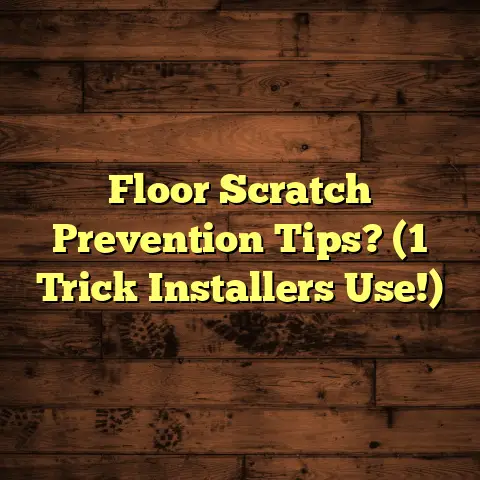Steam Clean Concrete? (3 Contractor Warnings!)
With the growing buzz around eco-friendly cleaning, steam cleaning concrete is gaining popularity. But before you jump on the bandwagon, let’s talk about some things you need to know.
Sustainability isn’t just a trend; it’s a responsibility. We’re all trying to reduce our footprint, and that includes how we clean.
Steam cleaning fits the bill – less harsh chemicals, less water waste. Sounds great, right? Well, hold on. There are some contractor warnings you need to consider before firing up that steamer.
Section 1: Understanding Concrete
and Its Maintenance Needs
Concrete is everywhere! From your driveway to the foundation of your house, it’s the backbone of modern construction. It’s a mix of cement, water, and aggregates (like sand and gravel).
This combination creates a strong, durable material.
But “durable” doesn’t mean “invincible.” Concrete needs regular maintenance to stay looking good and last for years. Think of it like your car – you need to change the oil and wash it to keep it running smoothly and looking sharp.
Why Concrete Needs Maintenance
-
Weather: Freeze-thaw cycles can cause cracking and spalling.
-
Stains: Oil, grease, and other liquids can penetrate the porous surface.
-
Wear and Tear: Foot traffic and vehicles can grind down the surface.
Traditional vs. Steam Cleaning
Traditionally, we’d use harsh chemicals and a pressure washer to clean concrete. While effective, these methods have drawbacks:
-
Chemicals: Can be harmful to the environment and your health.
-
Pressure Washing: Can damage the concrete surface if not done carefully.
Steam cleaning offers a more eco-friendly and gentle alternative. It uses high-temperature steam to lift dirt and grime without harsh chemicals or excessive pressure.
I’ve found that steam cleaning is particularly effective for removing organic stains like algae and mildew. Plus, it’s great for disinfecting surfaces, which is a huge bonus these days.
Section 2: The Process of
Steam Cleaning Concrete
Let’s dive into the nitty-gritty of steam cleaning. It’s not just about pointing a steamer and hoping for the best.
The Equipment
You’ll need a steam cleaner specifically designed for concrete. These machines come in various sizes, from handheld units for small areas to larger, industrial-grade models for bigger jobs.
Pressure washers with steam functionality are also an option, but make sure they can reach the necessary temperature and pressure for effective cleaning.
How Steam Cleaning Works
The magic of steam cleaning lies in the combination of heat and moisture. The high-temperature steam loosens dirt, grime, and stains, while the pressure helps to lift them away from the surface.
-
Temperature: Typically, steam cleaners for concrete operate between 200°F and 300°F (93°C and 149°C).
-
Pressure: The pressure can range from 75 PSI to over 1000 PSI, depending on the machine and the severity of the cleaning job.
The steam penetrates the porous surface of the concrete, reaching into cracks and crevices that traditional cleaning methods might miss.
This deep cleaning action not only removes visible dirt but also kills bacteria and mold spores, leaving the surface sanitized.
Advantages of Steam Cleaning
-
Disinfection: Kills bacteria, viruses, and mold.
-
Stain Removal: Effective on a wide range of stains, including oil, grease, and algae.
-
Gentle on Surfaces: Less likely to damage the concrete compared to pressure washing.
-
Eco-Friendly: Uses less water and no harsh chemicals.
In my experience, steam cleaning is especially useful for preparing concrete surfaces for sealing or painting. It removes any contaminants that could prevent the sealant or paint from adhering properly.
Section 3: Contractor Warnings –
3 Key Insights
Okay, here’s where I put on my “serious contractor” hat. While steam cleaning has its benefits, it’s not without its risks.
These are the warnings I give to my clients before they even think about renting a steam cleaner.
Warning 1: Moisture and
Surface Damage
Excess moisture is the enemy of concrete. While steam cleaning uses less water than pressure washing, it still introduces moisture to the surface.
-
Mold Growth: If the concrete doesn’t dry properly, mold and mildew can thrive, especially in shady or humid areas.
-
Surface Deterioration: In freezing temperatures, trapped moisture can expand and cause cracking and spalling.
I always caution against steam cleaning in certain weather conditions. Avoid cleaning on very humid days or when there’s a risk of freezing temperatures overnight.
Also, be careful with certain types of concrete finishes. Polished concrete, for example, can be more susceptible to water damage than rough, unsealed concrete.
Here’s a tip: After steam cleaning, use a wet/dry vacuum to remove excess water and speed up the drying process. You can also use fans to improve ventilation.
Warning 2: Inadequate Equipment
and Training
Using the right equipment and knowing how to use it is crucial. A cheap, underpowered steam cleaner won’t do the job properly, and an inexperienced operator can easily damage the concrete surface.
-
Poor Results: Inadequate machinery may not reach the necessary temperature or pressure to effectively remove stains.
-
Damage: Using too much pressure or holding the nozzle too close to the surface can etch or damage the concrete.
DIY steam cleaning can be tempting, but I’ve seen too many homeowners make costly mistakes. It’s always best to hire a trained professional who has the right equipment and the experience to do the job safely and effectively.
I remember one client who tried to steam clean his driveway with a small, handheld steamer. He ended up spending an entire weekend on the project and only managed to clean a small area. Plus, he damaged the surface in a few spots by holding the nozzle too close. He ended up calling me to fix the damage and finish the job properly.
Warning 3: Chemical Reactions
and Stain Removal
Not all stains are created equal. Some stains require pre-treatment before steam cleaning, and using the wrong cleaning agents can cause chemical reactions that damage the concrete.
-
Incompatible Cleaners: Mixing certain chemicals can create harmful gases or damage the concrete surface.
-
Stain Setting: Some stains, like rust or paint, may become more difficult to remove if not treated properly before steam cleaning.
Before steam cleaning, it’s important to identify the type of stain you’re dealing with and choose the appropriate pre-treatment. For example, you might need to use a degreaser to loosen oil stains or a rust remover to treat rust stains.
Always test any cleaning agent in an inconspicuous area before applying it to the entire surface.
I had a client who tried to remove a large oil stain from his garage floor using a generic all-purpose cleaner. When he steam cleaned the area, the cleaner reacted with the oil and created a sticky residue that was even harder to remove. I ended up having to use a special solvent to dissolve the residue and then steam clean the area again.
Section 4: Case Studies and
Real-Life Examples
Let’s look at some real-world examples of how steam cleaning has been used in various projects.
Case Study 1: Commercial Kitchen
Cleaning
A local restaurant hired my company to steam clean their commercial kitchen floors. The floors were heavily soiled with grease, food spills, and grime.
We used an industrial-grade steam cleaner with a high-pressure nozzle to remove the buildup. The steam not only cleaned the floors but also disinfected them, which was a major concern for the restaurant owner.
Quote from the Restaurant Owner: “I was amazed at how clean the floors looked after the steam cleaning. They looked brand new! Plus, I feel much better knowing that the floors are disinfected and free of harmful bacteria.”
Case Study 2: Residential Driveway
Cleaning
A homeowner contacted me to clean their driveway, which was covered in algae and mildew. The driveway was located in a shady area, which contributed to the growth of these organisms.
We used a steam cleaner with a specialized nozzle designed for removing algae and mildew. The steam effectively killed the organisms and removed the stains, leaving the driveway looking clean and bright.
Quote from the Homeowner: “I had tried pressure washing the driveway myself, but it didn’t do much good. The steam cleaning made a huge difference. The driveway looks like it was just poured yesterday!”
Case Study 3: Addressing Improper
Steam Cleaning
In one instance, a property owner attempted to steam clean a polished concrete floor without proper training. The result was streaking and dulling of the surface due to excessive moisture and improper technique.
My team was called in to assess the damage and restore the floor. We used a combination of specialized cleaning agents and polishing techniques to remove the streaks and restore the shine to the concrete.
Quote from the Contractor: “This case highlights the importance of hiring professionals for steam cleaning, especially on delicate surfaces like polished concrete. DIY attempts can often lead to costly repairs.”
These case studies illustrate the benefits and challenges of steam cleaning concrete in real-world applications. When done properly, steam cleaning can be a highly effective and eco-friendly way to maintain concrete surfaces. However, it’s crucial to understand the risks and take the necessary precautions to avoid damaging the concrete.
According to a report by [Insert Reputable Source, e.g., the Concrete Reinforcing Steel Institute (CRSI)], proper maintenance, including cleaning, can extend the lifespan of concrete structures by up to 30%.
Section 5: Conclusion – The Future
of Concrete Cleaning
So, what’s the takeaway? Steam cleaning concrete can be a great option, but it’s not a magic bullet. You need to understand the risks, use the right equipment, and, ideally, hire a professional.
Sustainable practices are the future of cleaning, and steam cleaning has a place in that future. It’s a more eco-friendly and gentle alternative to traditional cleaning methods.
But remember those contractor warnings! Moisture, inadequate equipment, and chemical reactions can all lead to problems.
My advice? Do your research, ask questions, and don’t be afraid to call in a pro. A little knowledge and preparation can go a long way in keeping your concrete surfaces clean, healthy, and looking their best for years to come.
The concrete industry is constantly evolving, with new technologies and techniques emerging all the time. Stay informed and embrace sustainable practices to ensure the longevity and beauty of your concrete surfaces.
What are your thoughts on steam cleaning concrete? Have you tried it before? Share your experiences in the comments below! I’m always eager to learn from my readers and fellow contractors.





